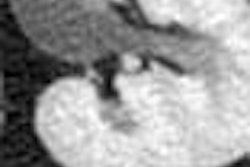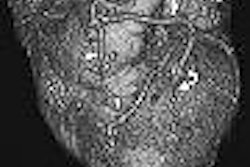SAN FRANCISCO - Several years after the publication of Dr. David Brenner and colleagues' eye-opening report on the risk of CT-induced cancer in children, questions about the dangers of ionizing radiation still hover uneasily in the minds of physicians and parents around the world (AJR, February 2001, Vol. 176, pp. 289-296).
The concern is understandable, considering that CT use continues to, well, spiral, replacing x-ray and even clinical exams in an ever-growing list of applications. As reported in 2000 by the United Nations Scientific Committee on the Effects of Radiation (UNSCEAR, 1991-1996 data), in level 1 countries CT imaging accounted for 6.1% of all imaging exams, yet contributed 40.6% of the annual collective dose. Per 1,000 in population, residents of the U.S., Germany, the Netherlands, and the U.K. underwent 91, 64, 32, and 22 CT scans, respectively. The U.S. performs nearly 25% of the world's CT scans, not including those performed in Japan, the runner-up.
More recently, the FDA's NEXT survey estimated some 58 million annual exams in 2000-2001, while the 2004 U.S. census from market research firm IMV Medical Information Division of Des Plaines, IL, estimated that 45.4 million CT studies are conducted annually. Meanwhile, CT utilization is expected to continue growing by 4%-10% per year.
Are these exams dangerous? Are all of them necessary? Yes and no, according to the results of a debate at the International Symposium on Multidetector-Row CT, sponsored by Stanford University of Stanford, CA. In yesterday’s opening sessions, two radiologists from the Netherlands dutifully spelled out the opposing positions assigned to them by conference organizers.
CT and the case for real risk
"Linear non-threshold (LNT) dose relation is the best approximation of individual risk and current use patterns, and the steady increase in the use of CT will result in relevant public health risks on the population level," said Dr. Aart van der Molen from Leiden University Medical Center in the Netherlands. "Users are still unaware of dose levels and dose risks, and optimization on a nationwide basis is quite a slow process," he said. "There is a lack of justification and of evidence of benefit/risk ratios of CT in some places."
Radiation risks can be divided into deterministic effects such as skin injuries, GI syndrome, cataracts, and stochastic effects, including carcinogenesis and genetic effects, he said. Most of the risk data come from World War II Japanese atomic bomb survivors, of course, as reported by the Radiation Effects Research Foundation (RERF). The results show a small but statistically significant risk in the 0-100 mSv radiation range (Radiation Research, October 2003, Vol. 160:4, pp. 381-407).
"However, true-positive evidence from epidemiological studies is never measurable, because if you want to measure something in the 10 mSv range you would probably need a population of 10 million that you would follow their entire lives," van der Molen said. Nevertheless, the LNT dose relationship is the most comprehensive model available.
A report from the National Council on Radiation Protection and Measurements examined all of the previous atomic bomb survivor studies (data 1950-1997) and estimated that among 86,500 bomb survivors, 440 (4.9%) of the solid-cancer deaths and 250 (0.8%) of the non-cancer deaths were associated with radiation exposure (Health Physics, July 2003, Vol. 85:1, pp. 15-22).
The report concluded that "...the weight of evidence suggests that lesions that are precursors to cancer (i.e., mutations and chromosome aberrations), and certain types of cancer as well, may increase in frequency linearly with the dose in the low-dose domain. On this basis, the committee concluded that no alternative dose-response model is more plausible than the linear non-threshold model, although other dose-response relationships cannot be excluded, especially in view of growing evidence that the dose-response relationship may be modified by adaptive responses, bystander effects, and other variables."
Another study found that despite the lack of evidence of risk from low radiation levels, there is reasonable-to-good epidemiological evidence for increased cancer risk for acute exposures with doses above 10-15 mSv.
For its part, the International Commission on Radiological Protection calculated the excess risk of cancer at 5% per Sievert for fatal cancers, and an additional 1% per Sievert for non-fatal cancers overall, though the risk was significantly higher in children (e.g., 0.3% for female newborns) and lower for older people (e.g., 0.01% for 60-year-old males).
"What happened with multidetector?" van der Molen asked. "We got increased productivity per scanner, we did more multiphasic exams, and we found newer indications, not always the lowest-dose ones, including coronary CTA, CT urography with up to four phases per exam, (and) total-body trauma CT. Don't look at the patient anymore, get him off the helicopter and put him in the CT scanner. (There is) kidney stone CT, and new indications like dynamic perfusion CT."
In his institution, CT accounts for about 9% of all radiologic exams, but 68% of the collective radiation dose, van der Molen said. One study calculated deaths from CT-induced cancers at 208 per year in the Netherlands, and 5,695 annual deaths in the U.S.
Also troubling, a study of radiation dose awareness found that 50% of emergency physicians and 60% of radiologists underestimated the radiation dose that they delivered in a given CT exam (Radiology, May 2004, Vol. 231, pp. 393-398).
And despite a plethora of recent articles on low-dose pediatric CT techniques, a survey of Society of Pediatric Radiology members found that only 4% used less than 120 kVp, 11%-44% still used high mAs values, especially in older children, and that a substantial number of CT scans were done without major adjustments for weight (American Journal of Roentgenology, February 2003, Vol. 180:2, pp. 401-406). An ALARA (as low as reasonably achievable) symposium found that 10%-30% of pediatric CT is not justified.
"LNT dose relation, in my view, is the best we have today, and it shows a small individual risk," van der Molen said. "However, on a societal level, a large number of exams will turn a small risk into a considerable health risk. CT use is high and steadily increasing, and the increase in use is faster than the decrease in dose per exam. The number of unjustified CTs may be considerable. Users are still not enough aware of doses and risk, and this all results in a collective risk for the public that I think may be increasing in the future."
Weighing CT risk
Following van der Molen was Dr. Mathias Prokop from the University Medical Center in Utrecht, the Netherlands, who had the unenviable job of convincing symposium attendees that "dose issues are not really important," he said.
But with regard to radiation risks, a couple of very important questions stand out, he said. First, is there a real radiation risk for CT? Second, what about individual risk relative to population risk? One has to look at the effect of limited healthcare resources as well.
"Malignancy increases over time, and malignancy is strongly age-dependent," Prokop said. "Above 200 mSv there is no (doubt) that there is a linear risk dependency between radiation-induced cancer and radiation. Below 5 mSv we'll probably never be able to prove (risk), and if you look at the A-bomb survivors (half of whom who received less than 5 mSv) you actually had less cancer deaths than expected in a (normal) population group. Somewhere between 5 mSv and 200 mSv we have a lack of good data, and we have to form a curve which is based on radiological models."
But the task of filling in the curve accurately has confounded generations of researchers; for one thing there is massive standard deviation. Radiation risk is strongly age- and sex-dependent. Brenner and colleagues found that only above 125 mSv of exposure was there a small but statistically significant increase, Prokop said.
There are a number of problems with the LNT model as well, he said. The theory asserts that as photons pass through cells they cause mitochondrial damage, and further that the damage increases in a linear fashion with the increase in photons, or radiation dose.
Yet "the risk for small animals like mice, and the risk for us is the same, and we have definitely more cell nuclei, but we don't get more liver cancers or colon cancers," Prokop said. "That means there must be some type of repair mechanism that plays a role," he said, and a few have been documented.
Prokop said that a threshold model may actually work better than the LNT for leukemia and sarcoma data, according to the recent Health Physics study on atomic bomb survivor data.
"...the fit of the A-bomb solid tumor and leukemia incidence data are significantly improved by the addition of a threshold term in comparison with the purely linear or linear quadratic model," the authors wrote. "The results from the mortality data suggest that the leukemia data agree more with the threshold model than the linear quadratic model, although the linear quadratic model is statistically equivalent, while the solid tumor data does not suggest any improvement with a threshold" (Health Physics, December 2003, Vol. 85:6, pp. 709-20).
Considering radiation hormesis
Then there is the radiation hormesis model, which suggests that at very low levels, radiation may have a protective effect. And while the evidence is conflicting, some evidence in favor of that model can be seen at the cellular level.
"There is, for example, the production of enzymes that repair RNA damage that's upregulated (with radiation exposure)," Prokop said. "There is stimulation of apoptosis, basically the suicide of damaged cells. Also for low radiation we find a stimulation of human T killer lymphocytes; in other words, a stimulation of the immune system. At high doses, it's inverse. And the stimulation of scavenging processes is also stimulated (with radiation)."
Finally, he said, no study has really proven a risk in the range below 20 mSv, the range most radiologists work in with their patients. Still, the LNT theory is legally accepted, and remains the basis of most regulation around the world, including in the European Union, and soon in the U.S.
"We should be prudently using radiation, despite the fact that there's no proven damage in our CT dose range," Prokop said.
A recent study by Berrington de Gonzalez looked at the risk of cancer from x-rays in 15 countries, with data corrected for factors such as age, frequency of radiologic exams, type of exposure, etc. Yet the group found it could not correct for prognosis; a cancer patient has a different prognosis than an age-matched control, for example. The authors concluded that the population effects of radiologic exams may well be overestimated, Prokop said (The Lancet, January 31, 2004, Vol. 363:9406, pp. 345-351).
At the same time, one must be very careful with the use of radiation in children, in anyone with benign disease, and in the case of frequent follow-ups, Prokop said. But overall, given a population risk of about 33% of cancer death, the comparative risk of a chest or abdominal CT of 0.05% (10 mSv) is comparatively insignificant.
The risks of not scanning
Comparative risks are also highly relevant, Prokop said. If a radiologist opts for a chest x-ray over a chest CT in suspected thoracic trauma, he risks missing 30% to 40% of clinically significant injuries, some of which are potentially life-threatening. Similarly, a third of patients with embolism will die if it is not found and treated; a negative CT is a good sign, as embolism recurs in less than 1% of patients, he said.
"What we have to weigh is, on the one hand, the acute and immediate risk for the patient, and on the other side, a long-term very low risk," Prokop said. Without CT, the immediate risks include wrong diagnosis, no diagnosis, or delayed diagnosis.
Clinical diagnosis, ultrasound, and MR are possible alternatives to CT, but each carries risks of its own. Clinical diagnosis is often unreliable; MR is substantially more expensive and may require sedation in children. Relying on MR exclusively would mean fewer exams on a limited budget, as most MR exams are more than twice as expensive as CT. And ironically, ultrasound exams often generate additional CT exams to resolve questions that arise from the first look, and most such findings turn out to be benign.
"CT poses a very low stochastic long-term risk, which probably will not manifest tomorrow, but only in a number of years," he said. "And it grows over time, so the younger the patient, the more risk you will have. CT is justified if the disease risks outweigh the excess radiation risks. This is almost always the case in life-threatening diseases."
Still, radiologists should avoid numerous repeat follow-up scans in cancer patients with complete remission, and in patients with reduced life expectancy, for example. It is also important to adapt dose to patient size, adapt the dose to the indication, differentiate between high- and low-dose indications, and lower the dose in kids and contrast-enhanced chest CT, he said.
"Scan thin (slices) and reconstruct thick, which is one of my favorite ideas," Prokop said. "I think that CT does have a role, the risk is very limited, and actually there is room for a lot of improvement on our side to get that low risk even lower."
Both Prokop and van der Molen agreed that better dose reduction and dose awareness are essential, as are stricter justification for the use of CT exams, and quantification of the modality’s benefits in a given exam. This will require more detailed guidelines, accreditation, and quality criteria in order to maximize the benefits and minimize the risks of CT, they said.
By Eric Barnes
AuntMinnie.com staff writer
June 24, 2004
Related Reading
U.S. to evaluate whether x-rays should be labeled carcinogens, February 18, 2003
Studies cast doubt on low-level radiation dangers, January 30, 2003
Worrisome radiation dose seen in CT lung screening, follow-up, December 23, 2002
Limiting PET radiation exposure requires tools, techniques, October 25, 2002
Even moderate doses of radiation may cause nervous system tumors, October 16, 2002"
Copyright © 2004 AuntMinnie.com



















